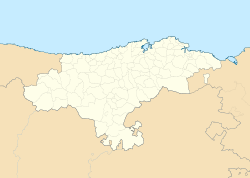Santander, Cantabria
| Santander | |||
|---|---|---|---|
| Municipality | |||

Top left: Assumption of the Virgin Mary Cathedral, Top right: Santander City Hall in Calle de los Escalantes, Middle left: Palacete del Embarcadero, Middle right: View of Sardinero Beach and Magdalena Palace, Bottom left: Cape Mayor Lighthouse, Bottom right: View of a ferry leave from Santander in Magdalena Peninsula
|
|||
|
|||
| Location of Santander within Cantabria | |||
| Coordinates: 43°27′46″N 3°48′18″W / 43.46278°N 3.80500°WCoordinates: 43°27′46″N 3°48′18″W / 43.46278°N 3.80500°W | |||
| Country |
|
||
| Autonomous community |
|
||
| Province | Cantabria | ||
| Comarca | Bay of Santander | ||
| Judicial district | Santander | ||
| Founded | 26 BC, as Portus Victoriae Iuliobrigensium 9 January 1755, granting the title of city | ||
| Capital | Santander | ||
| Government | |||
| • Alcalde | Gema Igual (2016) (PP) | ||
| Area | |||
| • Total | 35 km2 (14 sq mi) | ||
| Elevation | 15 m (49 ft) | ||
| Highest elevation | 108 m (354 ft) | ||
| Lowest elevation | 0 m (0 ft) | ||
| Population (2013) | |||
| • Total | 178,465 | ||
| • Density | 5,100/km2 (13,000/sq mi) | ||
| Demonym(s) | Santanderino/a, santanderense, pejino/a, chani | ||
| Time zone | CET (UTC+1) | ||
| • Summer (DST) | CEST (UTC+2) | ||
| Postal code | 39001-39012 | ||
| Official language(s) | Spanish | ||
| Website | Official website | ||
The port city of Santander (UK /ˌsæntənˈdɛər, -tæn-/, US /ˌsɑːntɑːnˈdɛər/;Spanish: [santanˈder]) is the capital of the autonomous community and historical region of Cantabria situated on the north coast of Spain. Located east of Gijón and west of Bilbao, the city has a population of 178,465 (2013). Santander houses the headquarters of multinational bank Banco Santander, and is the location of the founding of the namesake company.
The origin of the earliest human settlements in the current Santander is not easy to establish because there are few written and archaeological data. However, there would appear to be good practical reasons for ancient settlers to have chosen the north side of the bay, sheltered from it and safer from the storms of the Bay of Biscay, on the north side of the promontory of Somorrostro and along the ancient Becedo estuary. Moreover, the hillside provided good visibility for spotting potential attackers, making this the ideal place for the foundation of a stable settlement, which was to evolve throughout the Middle Ages.
...
Wikipedia



